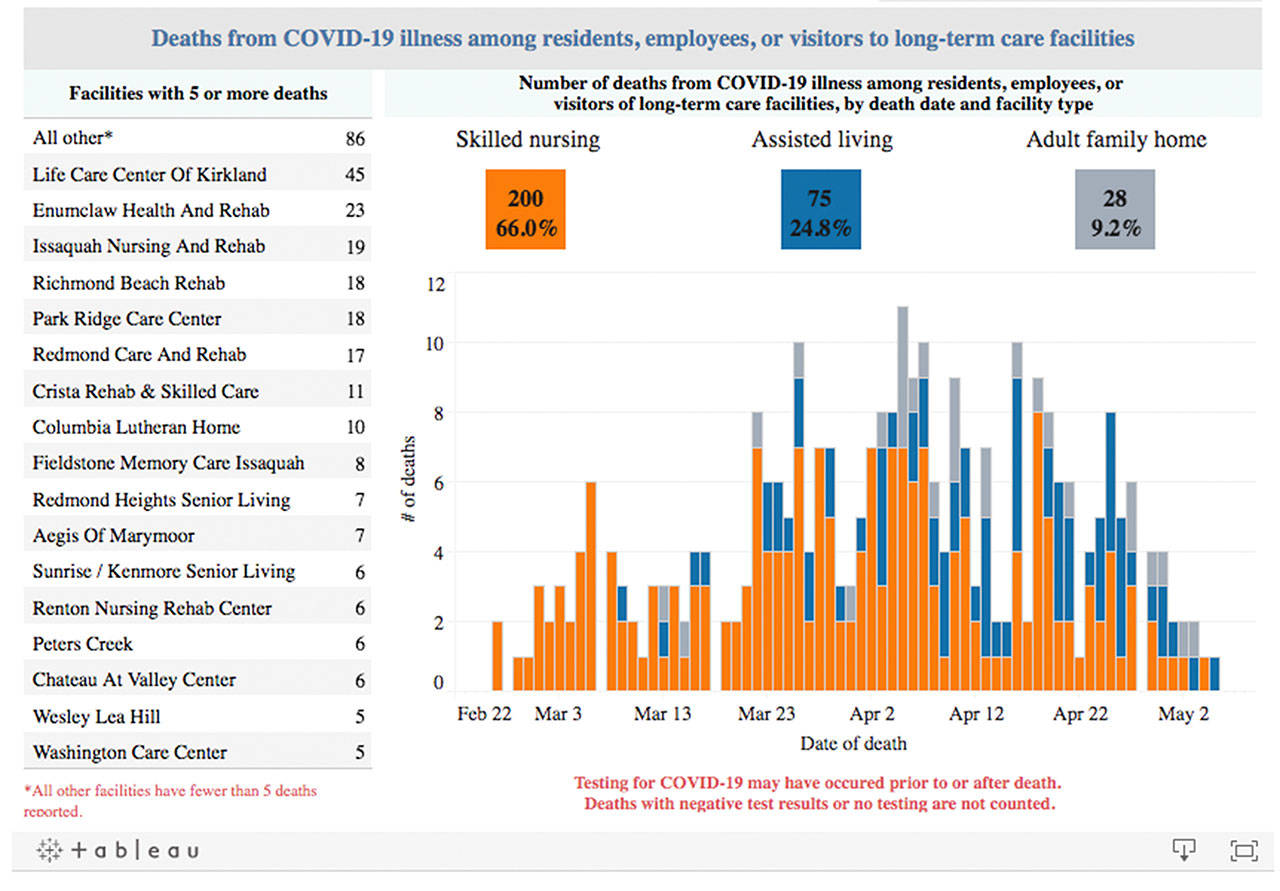According to new COVID-19 data from King County, the Enumclaw Health and Rehabilitation Center is near the top of the list when it comes to coronavirus deaths in long-term care facilities in the area.
As of May 7, it appears Enumclaw Rehab has reported 23 deaths, which is topped only by the Life Care Center of Kirkland, which suffered 45 deaths.
Trailing behind the local facility is Issaquah Nursing and Rehabilitation at 19 deaths; Richmond Beach Rehabilitation and the Park Ridge Care Center at 18, and Redmond Care and Rehabilitation at 17.
The dashboard, which can be viewed at https://www.kingcounty.gov/depts/health/covid-19/data/LTCF.aspx, is only naming long-term care facilities that have reported five or more deaths; facilities that reported fewer than five deaths were combined into one category.
An April 16 Department of Social and Health Services report on Enumclaw Rehab possibly explained why the facility had more deaths than nearly any other long-term care facility in the county.
According to the report, which sampled 15 residents inside the facility and five discharged residents, found “the facility failed to take appropriate actions related to a COVID-19 outbreak. These failed practices may have contributed to multiple residents and staff contracting COVID-19.”
The report noted that as of April 2, 38 residents and 10 staff had tested positive for the novel coronavirus, and five residents had already died, meaning the facility’s other 18 deaths occurred between April 3 and May 7.
According to the DSHS inspectors, staff appeared to not be properly screened for COVID-19 and were not properly informed on how to care for their personal protective equipment (PPE).
Additionally, the area where staff was screened was located at “the epicenter of the facility’s COVID-19 outbreak,” and staff only had an oral thermometer to test for fever, requiring people being screened to remove any mask in order to have their temperature taken.
The facility also appears to have failed to report when residents and staff showed symptoms of the virus in a timely manner, and was also slow in quarantining the roommates of patients who tested positive.
Finally, it also seems that patients were continuing to be admitted, or even re-admitted, into the facility even after an outbreak started.
Enumclaw Rehab did not respond to a request for comments.
OVERALL CASE AND DEATH STATS
The dashboard also shows skilled nursing facilities across King County — as opposed to assisted living facilities and adult family homes — had vastly more COVID-19 cases and deaths than other long-term care facilities. These cases and deaths are not necessarily just residents of those facilities, but staff and visitors as well.
Of the 52 skilled nursing facilities in the county, 36 (or nearly 70 percent) reported having COVID-19 cases, and as of May 7, there have been 200 total virus-related deaths in those facilities, accounting for two-thirds of all deaths inside long-term care facilities.
Roughly 25 percent of the 148 assisted living facilities in King County reported having COVID-19 cases, with a total of 75 deaths; only about 2 percent of the 1,164 adult family homes reported cases, and there were a total of 28 deaths.
The total of 303 deaths account for roughly 64 percent of all COVID-19 deaths in the county.
Although the majority of COVID-19 cases involved patients at these long-term care centers, around 335 total employees at these facilities reported becoming sick, with two deaths. Additionally, 23 visitors reported contracting the virus, with another two deaths. A dozen cases more and one additional death are still undetermined.
SYMPTOMS AND CO-MORBIDITIES
Patients in long-term care facilities that contracted COVID-19 reported having myriad symptoms.
The most commonly-reported symptoms were cough and fever, which were found in 39 and 38 percent of patients respectively.
About 27 percent of patients with the virus reported a shortness of breath, and 20 percent reported headaches.
Less common symptoms were pneumonia (16 percent), diarrhea (14.5 percent), sore throat (14 percent), chills (10 percent), nausea (9 percent), acute respiratory distress syndrome (9 percent), and vomiting (5 percent).
Roughly 32 percent of COVID-19 patients in long-term care facilities also reported “other” symptoms, which was its own category.
A third of patients also had at least one more condition in addition to having the coronavirus.
The most common co-morbidity (which only means concurrent conditions, and does not indicate death of these conditions) was heart disease at 18 percent.
Other co-morbidities included diabetes (13 percent), some sort of kidney disease (10 percent), and lung disease (9 percent).


